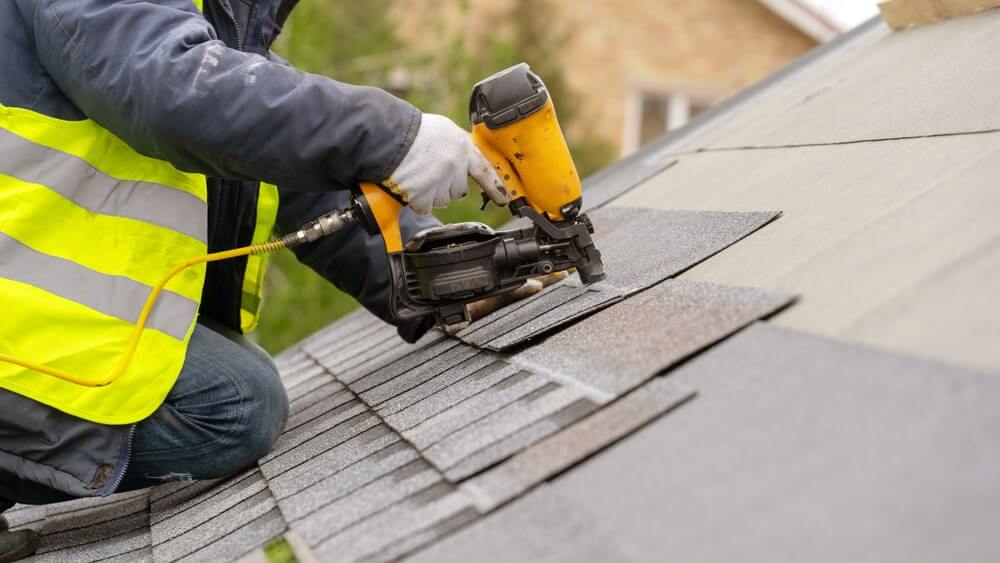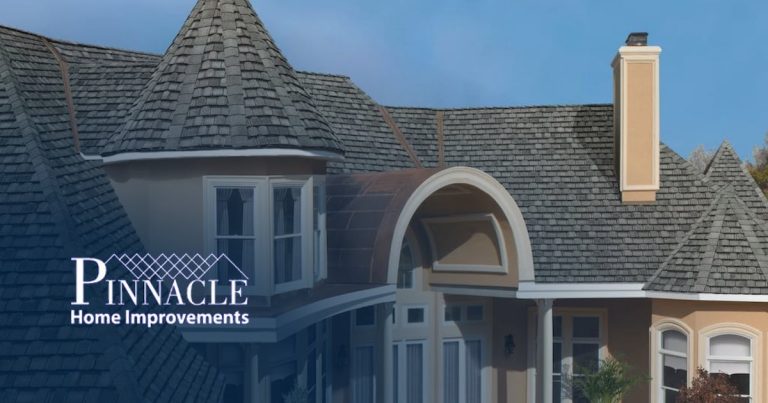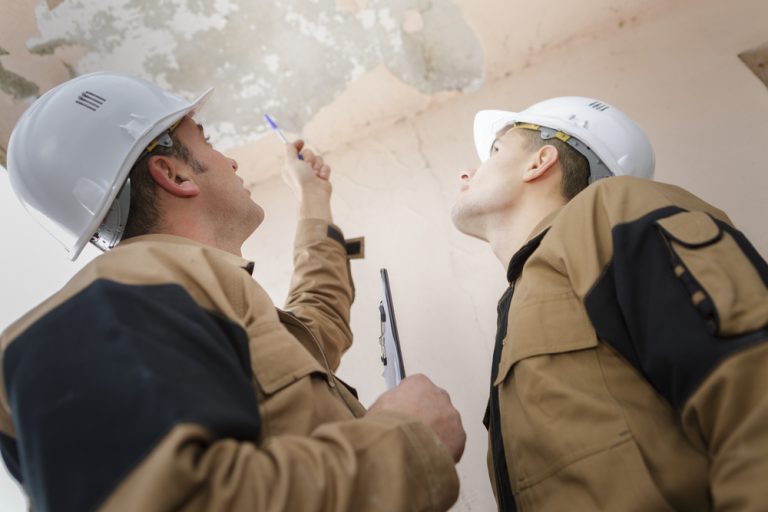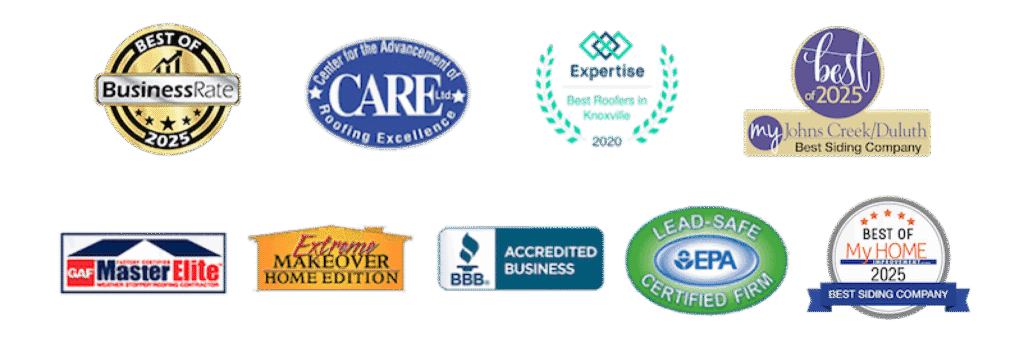At Pinnacle Home Improvements, we specialize in a wide range of home improvement services, including expert roofing services. As such, our team of experts is highly skilled in the installation and maintenance of asphalt shingles. We do much more than shingle roof installation and repair shingles though; we’re also here to educate the community in regards to asphalt roof replacement information.
Ready to learn more about residential shingles? In this article, we will provide a comprehensive guide to help you understand everything about asphalt shingles and how they can enhance your home’s aesthetics and functionality.

Everything You Need to Know About Asphalt Shingles: A Comprehensive Guide
Asphalt shingles are a prevalent choice for roofing in many parts of the world, favored for their cost-effectiveness, durability, and ease of installation. They consist of a base material coated with asphalt and then finished with a layer of protective granules. This construction provides a balance of flexibility and strength, allowing them to withstand a variety of environmental conditions. With a range of styles and colors available, they offer homeowners the ability to customize the look of their roof while ensuring a material that can endure for years to come.
The manufacturing process of asphalt shingles involves embedding a fiberglass mat or organic base with asphalt to create a waterproof barrier. The top layer of granules not only adds color and texture but also serves to reflect UV rays and provide additional weather resistance. The quality of the shingle can often be determined by its composition and the weight of asphalt used, with heavier shingles generally offering a longer lifespan.
From a sustainability perspective, asphalt shingles have seen improvements over time. Many manufacturers now incorporate recycled materials into their production and offer recycling programs for post-consumer shingles, helping to reduce the environmental impact of roofing waste. Additionally, specialized shingles are designed to improve energy efficiency by reducing heat absorption, contributing to lower energy costs for homeowners. It’s important for anyone considering a roofing project to understand these aspects to make an informed decision that aligns with their needs and values.
Types and Features of Asphalt Shingles
Asphalt shingles are a popular roofing material due to their cost-effectiveness and flexibility. This section provides a detailed look at the different types available and their distinct characteristics.
Exploring Varieties
Asphalt shingles come in a multitude of types, each offering unique features. Strip Shingles, commonly known as Three-Tab Shingles, are the most basic and cost-effective option. They consist of a single layer of asphalt topped with granules and are designed to look like three separate pieces when installed. Dimensional Shingles, sometimes referred to as Architectural Shingles, are multi-layered, providing a richer, more varied appearance and enhanced durability. Luxury Shingles are the premium choice, offering the highest level of durability, aesthetic appeal, and often resemble natural slate or shake roofing.
| Type | Layers | Durability | Aesthetic |
| Three-Tab Shingles | Single | Moderate | Basic |
| Dimensional Shingles | Multi | High | Varied |
| Luxury Shingles | Multi | Highest | Premium |
Comparing Three-Tab and Architectural Shingles
Three-Tab Shingles are characterized by their uniform appearance and flat profile. They typically have a shorter warranty period and lifespan compared to Architectural Shingles. Architectural Shingles boast a contoured, three-dimensional look and superior wind resistance. They are heavier than Three-Tab Shingles and tend to last longer due to their enhanced thickness and durability.
- Three-Tab Shingles:
- Weight: Lighter
- Durability: Moderate
- Lifespan: 15-20 years
- Cost: Less expensive
- Architectural Shingles:
- Weight: Heavier
- Durability: Higher
- Lifespan: 25-30 years
- Cost: More expensive
Understanding Dimensional Shingles
Dimensional Shingles are a subgroup within Architectural Shingles and are known for their dual-layer construction. This feature offers the appearance of natural wood shake or slate, adding depth to the roof’s appearance. These shingles often come with enhanced warranties due to their durability. They handle inclement weather better than their simpler counterparts, and their varied design tends to mask imperfections on the roof’s surface.
- Features of Dimensional Shingles:
- Construction: Dual-layered
- Appearance: Simulates wood shake or slate
- Weather Resistance: Superior
- Warranties: Lengthier due to durability
Benefits and Advantages
When selecting roofing materials, homeowners and contractors often opt for asphalt shingles due to their impressive balance of durability, cost-effectiveness, design versatility, and energy efficiency.
Assessing Durability and Longevity
Asphalt shingles are renowned for their robustness, offering a typical lifespan ranging from 20 to 30 years. They feature a fiberglass or organic mat coated with asphalt and topped with ceramic granules. This construction provides resistance to:
- Wind (up to certain speeds)
- Fire (with a Class A fire rating available)
- Algae growth (in algae-resistant shingles)
Regular maintenance and proper installation are key factors in maximizing the lifespan of these shingles.
Cost-Effectiveness
Among roofing materials, asphalt shingles stand out for their affordability. They present an economical option both in up-front cost and installation expenditure. Homeowners can expect:
- Low Initial Investment: Lower per-square-foot pricing compared to most other roofing materials.
- Reduced Labor Costs: Ease of installation translates to cost savings on labor.
The balance of affordability and quality makes asphalt shingles a preferred choice for budget-conscious building or renovation projects.
Design Versatility
Offering a wide range of colors and styles, asphalt shingles cater to diverse aesthetic preferences and architectural demands. They can mimic the appearance of pricier materials such as:
- Slate
- Cedar shakes
- Tile
This adaptability allows them to suit various house styles, from traditional to contemporary, enhancing curb appeal and potentially the property’s resale value.
Energy Efficiency
The right choice of asphalt shingles can contribute to a home’s energy efficiency. Specifically designed “cool” shingles reflect more sunlight and absorb less heat due to the presence of specialized granules. Benefits include:
- Cooler roof surface: Mitigates the urban heat island effect.
- Reduced cooling costs: The house stays cooler, decreasing the burden on air conditioning systems.
Moreover, some energy-efficient shingles may qualify for federal or state tax credits, offering further cost savings.
Choosing the Right Asphalt Shingles
Selecting the appropriate asphalt shingles involves several critical considerations. Homeowners should weigh factors such as local weather patterns, cost constraints, desired visual appeal, and potential maintenance needs.
Considering Climate and Weather Conditions
Climate plays a pivotal role in the selection of asphalt shingles. For regions with frequent severe weather, it is essential to choose shingles that can withstand extreme temperatures, heavy rain, hail, and high winds. Manufacturers often rate their shingles for performance in specific conditions, so look for ratings like wind resistance (e.g., 110 mph to 130 mph ratings) and impact resistance for areas prone to hail.
- Wind Resistance: Shingles rated for higher wind uplift.
- Impact Resistance: Class 3 or 4 shingles recommended for hail-prone areas.
- Algae and UV Resistance: Shingles with special coatings for humid or sunny climates.
Balancing Quality and Budget
When considering your budget, understand that higher quality shingles may offer longer lifespans and better warranties, but they come at a higher initial cost. Conversely, more economical options may necessitate earlier replacement or more frequent repairs.
- Economic Options: Three-tab shingles are cost-effective but less durable.
- Premium Options: Architectural or dimensional shingles cost more but provide superior longevity and aesthetic.
Aesthetic Considerations
Asphalt shingles are available in an array of colors and styles that affect a home’s curb appeal. Darker shingles can absorb more heat, while lighter shingles may reflect it, impacting home energy efficiency. Textural differences between three-tab and architectural shingles also influence the overall look of the roof.
- Color Options: Available from natural tones to bold shades.
- Style Variations: Three-tab (flat and uniform look) vs. architectural (contoured and dimensional look).
Maintenance Implications
The chosen type of asphalt shingle will dictate the maintenance required over its lifespan. While some shingles are low-maintenance, others may need more frequent cleaning or repair, especially in harsh weather environments.
- Maintenance Needs: Regular inspections and potential cleaning for algae or mildew.
- Durability: Architectural shingles often offer enhanced durability, reducing long-term maintenance costs.
Installation Best Practices
Proper installation of asphalt shingles is vital to the long-term durability and effectiveness of a roof. Detailed preparation, correct material laying, and precision in finishing work are core to a successful roofing job.
Site Preparation
Prior to beginning installation, the worksite must be thoroughly prepared. Professionals inspect the roof structure for any signs of damage, rot, or wear that could undermine the new shingles. It is critical to ensure the existing structure is sound and can support new roofing materials. Additionally, surrounding areas should be cleared of debris and hazards, and safety measures should be in place to protect workers and the property.
The Layers Beneath: Underlayment and Decking
The foundation for shingle installation is the roofing decking, which supports everything above it and provides a smooth surface for shingle application. Decking should be inspected for integrity and repaired if necessary. Above the decking, an underlayment of felt or synthetic material is rolled out. It serves as an additional barrier to wind and water. Correct underlayment application involves:
- Overlapping edges by at least 2 inches
- Securing the material with cap nails or staples
- Ensuring the surface is even and wrinkle-free
Expert Shingle Application
Employing appropriate shingle installation techniques is crucial. Starting with a starter strip at the roof’s edge ensures a clean look and effective seal. Shingles are then applied from the bottom up in overlapping rows, with professionals using six nails per shingle as a standard for high-wind areas. The pattern must be staggered to prevent water infiltration, a step commonly referred to as ‘staggering the shingle courses.’
Finishing Touches: Flashing and Ventilation
The final touches of installation involve flashing and ventilation. Flashing—thin metal pieces—is installed to direct water away from critical areas, particularly around chimneys, vents, and valleys. Proper ventilation is essential for managing moisture and temperature in the attic space. Ventilation components must be positioned strategically for optimal air flow, which is typically achieved by balancing intake vents at the eaves and exhaust vents at the ridge.
Maintenance and Upkeep
Maintaining asphalt shingles is critical to extending their lifespan and preserving the aesthetic appeal of one’s home. This section outlines effective methods for cleaning, troubleshooting issues, and the significance of routine inspections.
Effective Cleaning Strategies
Proper cleaning of asphalt shingles involves removal of algae, moss, and lichen which can damage the shingle surface over time. Use a garden hose and a soft-bristled brush, avoiding high-pressure washing which may strip granules from the shingles. For the best results, one should apply a solution made of equal parts water and bleach to the affected areas, allowing it to sit for about 15-20 minutes before rinsing thoroughly.
Troubleshooting Common Problems
Asphalt shingles can face a variety of issues including curling, cracking, and loss of granules. Curling shingles should be flattened and secured, while cracked or missing shingles must be replaced promptly to avoid leaks.
- Curling Shingles: Reattach with roofing cement.
- Cracked Shingles: Apply roofing sealant beneath the crack.
- Missing Shingles: Replace with new shingles, making sure to match the color and style seamlessly.
The Importance of Regular Inspections
Regular inspections are essential to identify small problems before they evolve into costly repairs. One should inspect their roof at least twice a year, in the spring and fall, to check for signs of wear or damage. It’s also wise to conduct additional inspections after extreme weather events. During these inspections, homeowners should look for:
- Missing, cracked, or curling shingles.
- Signs of algae or moss growth which can indicate moisture problems.
- Damaged or missing flashing around vents, chimneys, and other protrusions.
Following these maintenance and repair tips will help ensure the longevity and functionality of asphalt shingle roofing. If you need any help, remember that Pinnacle Home Improvements is here for you.














